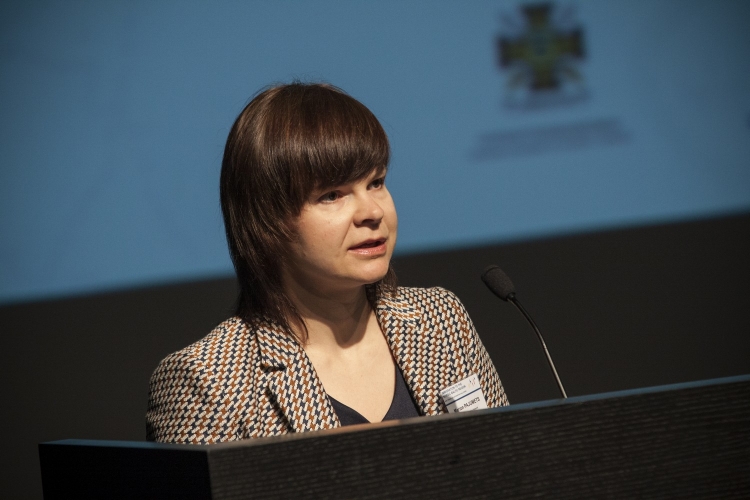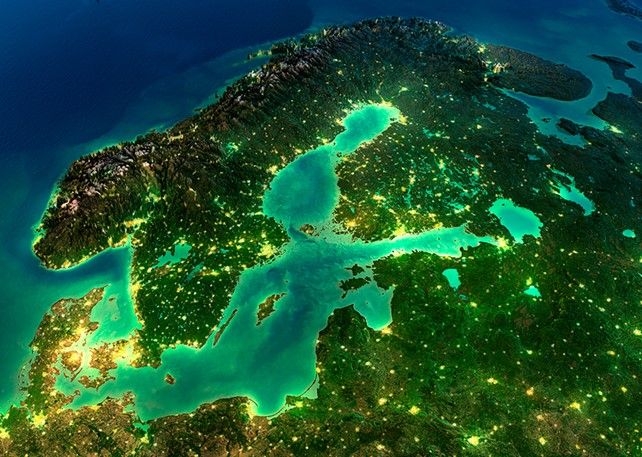Overview of second day of migration conference 2016: The role of the state and local authorities in receiving refugees

The second day (1 April) of the conference “Immigration to the Nordic-Baltic Region: New Trends and Integration Challenges” was focused on the role of the state and local authorities in receiving beneficiaries of international protection: which services are to be provided, and how issues like housing, language-learning and entering the labour market are being organised. The first half of the day was organised by the Estonian contact point of the European Migration Network. The overview of presentations from the second day of the conference was compiled by analysts from the European Migration Network.
Sheila Maas, a service provider from the European Commission, made a presentation about a study that analysed the policies and practices EU Member States apply to support beneficiaries of international protection in joining the labour market. As best practice, Member States mentioned such things as tying language-learning to working; providing adapted arrangements to simplify access to education (including further and vocational education) for beneficiaries of international protection; providing employment advice in as many different languages as possible; and promoting the recognition of vocational qualifications and academic certification.
There have also been shortcomings in Member States concerning the integration of beneficiaries of international protection into the labour market:
- creating special arrangements always leads to increased expenditure;
- the insufficient language skills of beneficiaries of international protection or the receiving country’s difficulties in finding interpreters;
- the lower education level of beneficiaries of international protection (there is no clear data concerning this in the EU, but initial information suggests that Syrian citizens, for example, are better educated);
- a lack of documents required to recognise education and skills, which in turn prevents people from accessing jobs fitting their profession;
- administrative obstacles and lengthy proceedings.
Maria Golubeva from the Centre of Public Policy in Latvia outlined her country’s experiences of integrating immigrants in terms of education and the labour market. The number of immigrants is rather low in Latvia. In 2015, 328 applications for asylum were lodged, with 29 people being granted international protection.
Latvia has put together an action plan for receiving internationally protected persons which forms part of the refugee relocation plan of the EU. Said action plan places emphasis on integration in the labour market. Although it is possible for internationally protected persons to start work three months after arriving in Latvia, insufficient Latvian skills (necessary for many jobs) make it difficult to enter the labour market. At the moment, Latvia also lacks regulations regarding the recognition of the vocational qualifications of protected persons who have lost documents proving their education and profession. As part of the action plan, Latvia has prescribed up to 120 hours of supported language courses for internationally protected persons and a supportive mentorship service which will be carried out by the Red Cross.
It is important to integrate immigrants in the labour market as Latvia is experiencing a labour shortage, especially in jobs requiring an average level of skills. One problem that was highlighted in the presentation was that after their work contracts end, immigrants are obliged to leave the country even if they have already found another job.
Katja Vänska-Rajala from the Finnish Ministry of Employment and the Economy summarised the general migration trends in Finland and the risks related to the new situation. In 2015, the number of people applying for international protection rose significantly – a tenfold increase compared to previous years. In addition, over 3000 unaccompanied minors entered the country. With respect to the increased number of people applying for international protection, it is estimated that this year at least 10,000 internationally protected persons will need housing and integration services. At the same time, local authorities do not have enough living spaces to offer people and this has given rise to the fear that reception centres may become overloaded and that there may be difficulties accessing integration services. The lack of integration services may lead to isolation, segregation and frustration.
Vänska-Rajala also spoke about challenges and good practice related to the integration of immigrants into the labour market. Unemployment rates are higher among internationally protected persons than among other immigrants. It can take up to 10 years for them to find employment, which is too long. A range of projects have been and will be carried out in Finland to promote and accelerate the integration of internationally protected persons into the labour market. The use of mentors, the directing of services to where customers are, workplace language training and individual guidance when looking for a job were highlighted as good practice that promotes the integration of internationally protected persons into the labour market.
Finland has launched a pilot project which aims to combine education and employment in a flexible way. What is innovative about the programme is that businesses invest in a fund created by the administrator of the project. The project is then financed with the help of the investment fund and without dipping into the state coffers. As a result, the country should be able to save money and investors can profit from their investments. The administrator of the project will receive performance pay. The project will be assessed in 2020, when the employment rate of participants will be compared to that of people who underwent the usual integration process.
Renata Kules, a representative of the United Nations High Commissioner for Refugees (UNHCR) in Lithuania, introduced a study that was conducted by the UNHCR in 2013 in cooperation with other organisations. Lithuania was given a range of recommendations on integrating internationally protected persons. It is important to individualise integration plans; provide systematic support; perform an analysis of the needs of the Lithuanian labour market; enable work and language studies to be combined; fight negative attitudes and stereotypes in society; and create a method and system of validating diplomas. It is also important to increase awareness in society.
As for the main developments since the research period, the presenter highlighted that Lithuania is now working on an integration strategy for internationally protected persons. By the end of 2016, an action plan will be completed which sets out important steps to be carried out with respect to integration.
Christoffer Melson, the chairman of the labour market committee of Vejle municipality in Denmark, provided an overview of the “Work First” programme they have implemented in Vejle. After a person is granted international protection, they are directed to the local authority. The local authority then organises a three-year adaption programme for the refugee, providing accommodation and advice on practical matters. Vejle has adopted a comprehensive approach that enables protected persons to integrate through their place of work. Refugees are introduced to different sectors and can choose the sector in which they have a real possibility to find work. After this, the refugee is sent to a company operating in that sector and they start training. Training and work are then combined with language studies. Refugees receive at least minimum wages for their work.
Melson highlighted the fact that refugees are highly motivated to find employment quickly. Immediately entering the labour market brings them, in turn, into contact with Danish culture and society. A structured programme is effective because people experience a lot of stress in their lives, which a routine weekly schedule helps relieve. People’s language skills have improved as well and the programme is useful for businesses.
As a result of the programme, the employment rate among refugees living in Vejle municipality is 10% higher than among those elsewhere in Denmark. We expect even better results in the future.
Triin Raag from the Estonian Ministry of Social Affairs explained which services generally also encompass internationally protected persons in Estonia. These services include the provision of housing, Estonian language courses, translation and interpretation services and support person services. The principle here is that the same services and benefits that apply to Estonian citizens are extended to internationally protected persons.
At present, there are differences in how we receive immigrants who arrive as part of ordinary international protection migration or as relocated refugees. For example, we seek out accommodation for relocated people before they arrive; we offer them psychological counselling; we perform health checks upon their arrival; and AMIF (an EU fund) guarantees financial resources for people who have been relocated (6000 euros per person, with half of the money going to local authorities).
According to the ministry, Estonia is constantly working to improve its preparedness for receiving internationally protected persons who have been relocated/resettled here. At the same time, Raag admitted that if it faces mass immigration, Estonia may find itself in a difficult situation.
Vladimir Šokman from Tartu City Council talked about local authorities’ initial experiences in receiving internationally protected persons.
In June 2015 a committee dedicated to multiculturalism was created under Tartu City Government. This committee incorporates experts on culture, education and employment (including people from the Estonian Unemployment Insurance Fund) as well as people providing support person services. In addition, meetings are held with ministries representing different fields, the police, universities, schools providing higher education, etc.
A lack of municipal apartments, available jobs and Arabic-speaking teachers and difficulties with vocational training etc. constitute problems. There is also potential for cultural and religious conflicts.
Eero Janson, the chairman of the NGO Estonian Refugee Council, talked about the role of civil society in receiving internationally protected persons in Estonia.
The support person service is a unique programme aiming to provide individual counsel. The NGOs Estonian Refugee Council and Johannes Mihkelson Centre are the primary organisations offering this service in Estonia. The service has:
- an official aspect – people are assisted in contacting state and other institutions such as the Estonian Unemployment Insurance Fund, educational institutions, a family physician and departments of the local authority;
- a practical aspect – people are advised while they settle in the country by e.g. showing them how to look for a job, how to continue or start their education, how the local public transport system works and how to plan their family’s budget; and
- a cultural aspect – people are helped in understanding the society and cultural background of Estonia.
In addition, individual language tutoring, interpreting and translation services are provided, a system of mentor families is being developed and work is being done to create international centres for bringing people from different cultures together. The motto of civil society upon receiving internationally protected persons should be: everyone can help.
View the presentations and video recordings from the conference here. Browse pictures. For more information about the migration and population development project launched by the Nordic Council of Ministers’ Office in Estonia in 2013, click here.


